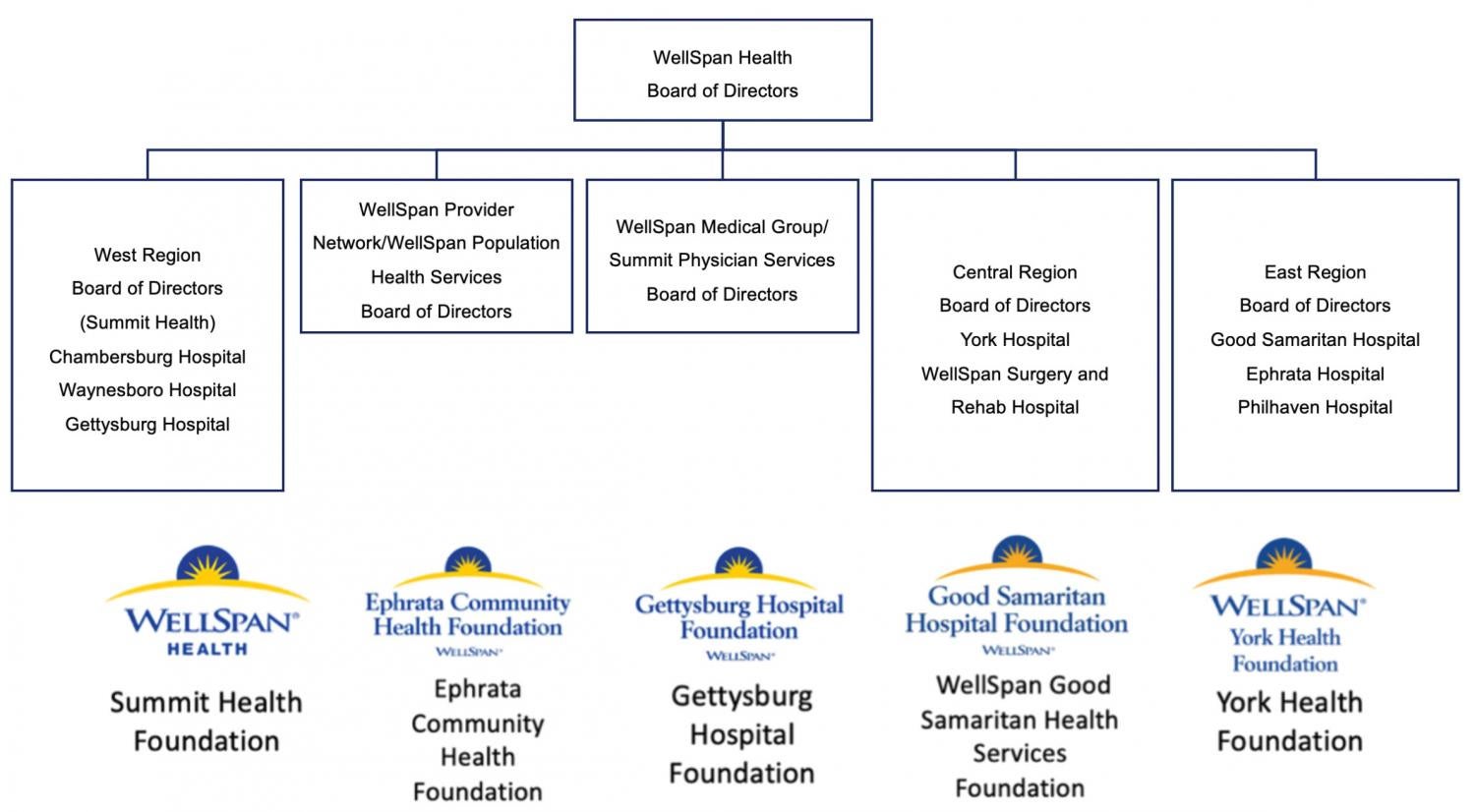
Strategic Governance
11 Principles for Health System Governance
WellSpan Health’s CEO describes its redesigned governance structure
By Roxanna Gapstur
As the only locally governed health system in south central Pennsylvania, WellSpan Health is uniquely invested in the communities we serve. With more than 1,750 employed providers, 200 patient care locations and eight hospitals, our integrated delivery system of 20,000 team members serves seven counties.
WellSpan has experienced significant growth over the last decade. As our health system and the field evolve, we remain dedicated to improving health in local communities, driven to bring our charitable mission to life through deep community connections and robust systems of care.
In 2019, as the incoming CEO, I was asked by the board to support the work of a newly formed governance task force. The collective work of WellSpan’s more than 40 boards of trustees had served WellSpan and our communities well. But the trustees knew they needed a governance review to transition to a model that would ensure a strategic, system-focused board to address current and future challenges.
Governance Strategic Review
The task force was chaired by a WellSpan Health board member and composed of 11 subsidiary board members. A subgroup of five task force members took on the bulk of the long-term work and developed final recommendations for the board. While I was very involved, I wasn’t a voting member of the task force. I was there to provide a system view and ensure governance conversations were reflective of our vision and strategy to lead the region in value.
As part of this thoughtful, intentional and inclusive strategic review, the task force engaged a national governance expert to ensure best practices were considered. The expertise and guidance were pivotal to our outcome.
One of the first and most important steps on this journey was the development of 11 WellSpan Governance Principles. The task force, with guidance from our national governance expert, worked diligently to build meaningful principles. When presented for the first time to the full board, the principles generated an engaging and robust governance discussion. It was obvious the adoption of the principles would signal a changed approach to governance at WellSpan.
As a result, the task force chair asked for the possibility of a vote on the principles — something we had anticipated doing at a later meeting. The board unanimously voted to accept the principles, acknowledging the thoughtful work of the task force. Our governance principles set the stage for the entire process and helped shape the final recommendations.
Elements of Enhanced Governance Structure
As a result of this process, we consolidated from more than 40 subsidiary boards down to 11, greatly simplifying and strengthening our system governance. We created a new governance committee on the system board and moved away from representative governance, a holdover from our many integrations. The committee established needs-based appointment criteria for trustees, requiring appointees to have the appropriate mix of skills needed to further the system’s strategic objectives.
Diversity was critical. We needed the board to look more like our community — more female, more people of color and more specific experiences in complex areas like audit and compliance, and IT. We also determined that board members will no longer be subject to age limits. In addition, based on best practice, the WellSpan Health board now meets six times per year, and an authority matrix guides decision-making through more clearly articulated board and management accountabilities.
The standing committees of this system board include: executive (meets ad hoc), governance, audit and compliance, compensation, finance, and planning and quality. Committee charters outline the scope and responsibility of each.
The new governance committee is responsible for developing governance policies and procedures, identifying specific skills and qualifications, nominating individuals for appointment to boards and committees, evaluating the individual and collective performance of trustees and officers, and recommending improvements in WellSpan’s governance process. The committee ensures there is a balance of power between other committees, the board chair and the full board.
And in alignment with best practice and the WellSpan Health board governing principles, trustees are limited to serving on one WellSpan Health board at a time. We believe this is important to ensure maximum diversity in ideas and expertise across our boards, as well as to allow focused time and attention to each board’s priorities.
New Board Structure
Our new board structure at WellSpan Health is outlined in figure 1.
Figure 1. WellSpan Governance Organizational Chart

Source: WellSpan Health.
Instead of eight individual hospital boards, we established three regional hospital “mirror” boards — west, central and east — that now provide local focus on clinical quality, safety and medical staff credentialing. This was important because many of the items coming to hospital boards were operational instead of strategic matters of policy and broad impact. Each regional hospital board comprises 13 to 15 members and is supported by the region’s senior vice president and the system’s chief quality officer. There are no standing committees connected to these boards other than site-specific credentialing committees as needed.
On the provider front, we decreased from two boards to one, creating a single guiding group for our employed providers. In addition, our WellSpan Provider Network/WellSpan population health services board continues in accordance with the governance requirements of the Centers for Medicare and Medicaid Services accountable care program participation.
The foundation boards did not change in structure and remain an important connection to our local communities, guiding our philanthropy and community benefit work.
Most other operational boards previously in place were not required from a governance perspective, and accountabilities have transitioned to management.
Key Factors for Success
No two-year long process involving broad participation and diverse voices is without its pitfalls. But overall, this was an efficient, productive process due in large part to three key factors.
First, those involved in the process made it a priority to understand what “systemness” really means. They knew it wasn’t about buying a group of hospitals and running them under one umbrella. They understood systemness to mean truly functioning as one entity. At WellSpan, we call it “Working as One” and it’s one of our core values.
Second, the involvement of a national governance expert provided a necessary outside perspective as well as authoritative expertise in health system governance. I would not recommend engaging in this work without a qualified governance expert in the mix. You must have the right people designing the approach. And if you’re the CEO overseeing this work, be supportive and engaged — but allow board members to debate tough issues and come to a resolution.
And third, our focus on stakeholder engagement and clear communication was critical to ensuring understanding and support. It was imperative that we widely conveyed the continued importance of community members on our regional and foundation boards, and that we communicated directly with each individual board member. The task force made it a priority to engage directly with every single one of the 40 boards, and to schedule “conversational goodbyes” with and recognition events for exiting board members. In between, they spent a lot of time as a task force (at least seven meetings of four hours each, not including board meetings) listening, learning, reading, conducting straw polls and engaging others in the process.
By taking a thoughtful, collaborative approach, we at WellSpan Health have completely redesigned our governance structure and positioned our health system for continued strong connections with local communities, moving us a step closer to our vision of “Trusted Partner, Reimagining Healthcare, Inspiring Health.”
This governance transformation was guided by the WellSpan governance task force and governance committee members: William (Bill) Funk, committee chair; Hilda Shirk, committee vice chair; Duane Britton; Richard Broadbent; Don Dreibelbis; P. Joshua Gluck; Bill Happel; Angela Heiland; Todd Marsteller; Suzanne McConkey; Larry Miller; Paul Minnich; Linda Pugh.
Roxanna Gapstur (rgapstur@wellspan.org) is the president and CEO of WellSpan Health, a health system in south central Pennsylvania.
Please note that the views of authors do not always reflect the views of the AHA.
